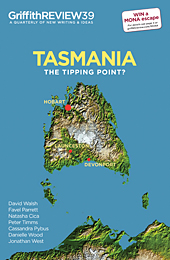Featured in

- Published 20130305
- ISBN: 9781922079961
- Extent: 264 pp
- Paperback (234 x 153mm), eBook
TASMANIA’S COMPLEX PLANNING system is often categorised as one of the main hurdles for anyone wanting to do business there – whether that be to expand, to improve or to open a business or other new venture.
It is, therefore, no surprise that after being a low-priority election issue for the past fifteen years, planning reform is now receiving some attention. This is largely because Tasmania is at a crossroads – either it will be able to compete with other states for business or it will forever remain dependent on the federal government for ‘bail outs’. Over the past decade Tasmania’s frequent solution to its overspending or inability to fund services has been to run to Canberra for money.
In my view, the latter is not a sustainable option and no Tasmanian should accept that as our destiny. It is degrading, it demoralises our people, and it destroys our brand. As a consequence, a vast majority of Tasmanians no longer feel proud of their State.
Changing other states’ perceptions of Tasmania will also not be easy and remains a challenge. Many are convinced that we cannot change (and perhaps don’t want to change). Many commentators – not just politicians – talk about ‘change’, but don’t offer solutions or ways of implementing change. Many people see Tasmania as a sovereign risk, largely because of the unstable and uncertain nature of the current (minority) government.
Recently I was speaking to someone professionally involved in liquidations and personal bankruptcies, and was told that there are currently low numbers of liquidations occurring in Tasmania. That is because businesses are taking fewer or no ‘risks’, preferring to be able to remain in business (even for no profit) rather than potentially losing it all. I’m not saying everyone should adopt risky business behaviour – but some element of risk can be healthy. It creates our ‘thinkers’, our innovators and our entrepreneurs. Most great changes and developments necessarily involve some level of risk.
THERE HAS NEVER been a better time to implement real planning reform in Tasmania. Other states, like New South Wales and Victoria, are implementing major reform in this area, which is generating competition between the states for development and investment opportunities. Tasmania’s challenge is that it has fallen behind other states in this race. The current promised planning reform by the state government (noting Labor has been in power for fifteen years in Tasmania) has been heralded by many industry commentators as being too slow and too little.
The challenge for Tasmania is to implement planning reform enabling us to compete with other states and territories in Australia, ideally so that Tasmania becomes an easier place in which to invest and develop than any other place in Australia. On top of our lifestyle and generally lower property prices, this should be a winning formula for us to earn the coveted title ‘open for business’.
Tasmania must also create wealth to fund our essential services – again, we cannot do this without a significant increase in investment.
Tasmania’s current planning system is acting as a handbrake on this much-needed investment and development. Consider the high number of ventures – including eco-tourism proposals – that have failed in Tasmania over recent years, because the planning process was so lengthy, complex and costly that these investors are unlikely to return, without reform. For example, Dick Smith’s eco-tourism development for Crescent Bay; other project still awaiting planning approval hopefully will not experience the same fate, such as the proposed Craggy Ridge Estate eco-tourist attraction.
Tasmania has a population of about 510,000 people, but has thirty-six different planning schemes in operation. This situation will not change sufficiently under the planning reforms proposed by the current state government – each of twenty-nine local councils will have its own different planning scheme. Delays, inconsistencies and confusion between municipalities inevitably will persist. It has been recognised by developers, planning advocates and industry commentators that a single planning scheme is needed in order to stimulate development in Tasmania. For example, Simon Cooper, the chairman of the Tasmanian Resource Management and Planning Appeal Tribunal, on theABC Stateline program on 15 November 2010 stated that: ‘There needs to be, as a matter of urgency one planning scheme, I think, for the State of Tasmania.’ This has been the Tasmanian Liberal opposition’s policy since shortly after I became Shadow Minister for Planning after the 2010 state election. This is achievable and no amount of excuses from the current government can hide the fact that the planning system in Tasmania is a mess.
Further, Hobart has no capital city plan in place, despite this being a requirement of COAG for future infrastructure funding of projects.
Tasmania is also without an updated comprehensive state coastal policy. The State Government completely abandoned its draft policy after seven years of formulation, reverting to an outdated 1996 policy which fails to adequately address issues such as coastal erosion.
Many developments are also bogged down and delayed by third party appeals. Virtually anyone can appeal a decision by a local council. The appeal process needs to be streamlined, should only include those with a genuine or proprietary interest, and should specifically exclude groups which are solely established to oppose a development. The right of appeal is a very important feature of our legal (and planning) system but there needs to be reasonable constraint.
For the benefit of the everyday homebuilder through to the property developer – and for the economic benefit of the larger Tasmanian community – we must develop a planning system that affords consistency across the state, one which offers streamlined and faster approvals, and a scheme that is fairer and less costly.
This does not mean development at all cost. Appropriate planning guidelines must always exist, but they do need to be uniform for all areas zoned the same, taking into account overlays including heritage considerations. Social, environmental, economic and other relevant impacts of a proposed development should always be considered. But what we currently have is thirty-six planning schemes that consider different factors, resulting in different outcomes across the state. Why should there be a different result or different conditions imposed, for example, in relation to development in an urban residential area with no heritage issues?
STRONG LEADERSHIP AND unity in government also enhances certainty for investors. In planning terms, leadership can be delivered through state policies on important planning matters such as land use planning, and land and resource management, which would assist local councils’ interpretation of the statewide planning scheme which I have advocated.
Currently, only three state policies exist, one of which desperately needs updating – as I have mentioned, the 1996 state coastal policy. Such matters require overarching State Policy for consistency in interpretation across all areas of Tasmania, providing the leadership and certainty so desperately needed.
Trust in government has been eroded in recent times, particularly after the last state election in 2010, when Labor formed government with the Greens after declaring throughout the campaign they would not.That trust clearly has to be rebuilt. A government which lives within its means, gets budget spending under control and has its priorities right should kickstart this healing process.
The collective vision must be a Tasmania that is one of the most competitive places to do business, one with the right environment to encourage investment and jobs growth. The focus must be to provide the best possible environment to encourage investment and for business to grow with confidence.
INNOVATION AND ACCESS to new markets is crucial to business success. As Steve Jobs said, ‘the cure for Apple is not cost-cutting. The cure for Apple is to innovate its way out of its current predicament.’ This undoubtedly applies to Tasmania.
How does innovation sit with sustainability? Jack Welch (an American chemical engineer, business executive and author who was chairman and CEO of General Electric between 1981 and 2001) said if sustainability ‘doesn’t create real jobs, it is no good’. Putting people out of work for the sake of sustainability for sustainability’s sake is, well, stupid. Jack Welch also famously said, ‘control your own destiny or someone else will.’
Getting business to invest in Tasmania, and getting people to move to Tasmania, requires the government to sell its vision. In my case, that vision includes delivering real planning reform, including cutting red and green tape. We must transorm Tasmania into a place where people can hardly wait to kick the door down to get in.
My job as a politician must be to inspire people to innovate, and create the environment for them to have a go. Failure should not be frowned upon, but should be recognised as a positive so that others are not deterred from also having a go. Innovation is too often seen as being just about delivering the next cutting edge product or service, but enormous value can also be created by developing better practices. This can include innovation that reduces inefficiencies in the delivery of health care and other government services. This does not necessarily mean implementing cost cutting measures, but it does mean spending wisely – in other words, creating ‘bang for your buck’.
Success needs to be better recognised and rewarded, and this may be as little as a positive comment to overcome the tall poppy syndrome. It is surprising the results you get by simply focusing on positives and not the negatives. In Tasmania, we should praise innovation (both success and failure) on the basis people are creating jobs, they’re having a go, and working towards building growth. Organisations – including governments – are also like human beings; they start to grow old and ‘die’ when they lose the ability to renew themselves.
Government does not have to have all the answers because entrepreneurs, business leaders and individuals will always find those. A government needs to have an articulate vision, open the road to recovery and allow the innovators to pave it. Government should be there to facilitate investment opportunities – let business run itself, but create an opportunity for it to thrive by effecting the right environment.
IT’S TIME FOR decisive action in Tasmania. I believe Tasmanians are craving stability, both political and economic. Tasmanians want to feel more certain about their future and especially about their children’s future. We need to look at the possibilities and start saying ‘yes’ to opportunities, utilising our strengths and finding ways to achieve an outcome. Tasmania can become an attractive place for economic investment and thereby job creation.
We just have to want to do it.
Share article
About the author

Elise Archer
Elise Archer MP was elected to the House of Assembly, Tasmanian Parliament in 2010.She is currently a (Liberal) Member for Denison and Shadow Minister...
More from this edition

Big thought and a small island
GR OnlineTHIS STORY STARTS, as many good stories do, with a conversation between a taxi driver and a customer. In this case, the trip was...

More than two stories
EssayA FRIEND ASKED me what drew me to live in Tasmania on and off for the past thirty years. I sketched an outline of...

On Bruny
FictionTHEY LEFT HOBART as dusk was falling. Not an orange dusk with stiff black silhouettes but a green dusk, slightly shaky, not quite sure...